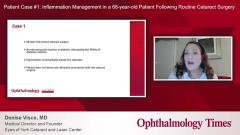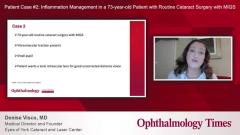
Takeaway points from patient case #1
Denise Visco, MD, MBA, discusses takeaway points from patient case #1 for post-operative inflammation management for routine cataract surgery.
Denise Visco, MD, MBA: The different perioperative treatment options for managing inflammation following cataract surgery discussed by the group included topical medications, intracameral medications, and subtenon injections, as well as intracanalicular dexamethasone. We looked at the pros and cons of each of these treatment regimens. We also looked at what the recent data shows as far as their efficacy in preventing CME [cystoid macular edema] and rebound iritis and inflammation after cataract surgery as well. The steroid formulations and regimens that are used in practice are prednisolone acetate, as well as the dexamethasone intracanalicular insert, intracameral DEXYCU [dexamethasone intraocular suspension]. The most effective delivery route for steroids was agreed to be topical prednisolone acetate.
We discussed in detail as well the recent ESCRS [European Society of Cataract and Refractive Surgeons] PREMED [PREvention of Macular EDema after cataract surgery] study [NCT01774474], which showed that combining topical steroids with topical NSAIDs decreases the risk of CME most effectively to roughly 1.5% with cataract surgery.
Finally, the group discussed adding intracameral phenolphthalein-ketorolac to the most effective combined topical, nonsteroidal with steroid. There are no studies that show the efficacy of this triple combination. However, studies showing intracameral phenylephrine-ketorolac with topical nonsteroidals decreases the cystoid macular edema risk rate to below 0.5%, which everyone was happy with. Our takeaway from this particular case was that we can’t get away from topicals yet, and in particular, topical nonsteroidal anti-inflammatory drops, combining topical nonsteroidal anti-inflammatory drops with intracameral phenylephrine-ketorolac yielded the lowest risk for CME, rebound iritis, and pain and inflammation with cataract surgery. However, most of the groups still felt most comfortable having a topical steroid on board for their perioperative cataract surgery management of pain and inflammation.
One of the studies that the group considered was a recent paper on a prospective study looking at whether combination topical nonsteroidal anti-inflammatory drops and steroids were superior at controlling early postoperative inflammation after cataract surgery compared with topical nonsteroidals alone, and also subtenon dexamethasone. What the study concluded was that no difference was found between the groups randomized to nonsteroidal monotherapy or the combination of nonsteroidal and steroid and controlling perioperative pain and inflammation with cataract surgery. However, the subtenon injection was inferior to both other protocols.
This particular study primarily looked at anterior chamber inflammation. That was one of the weaknesses, we felt, of the study, that it was focused on intersegment inflammation. And that doesn’t always translate to cystoid macular edema, pain, problems with iritis, and things like that after cataract surgery. That direct correlation with pain and inflammation was not there. But it was an impactful study in our discussion.
TRANSCRIPT EDITED FOR CLARITY
Newsletter
Don’t miss out—get Ophthalmology Times updates on the latest clinical advancements and expert interviews, straight to your inbox.



















































